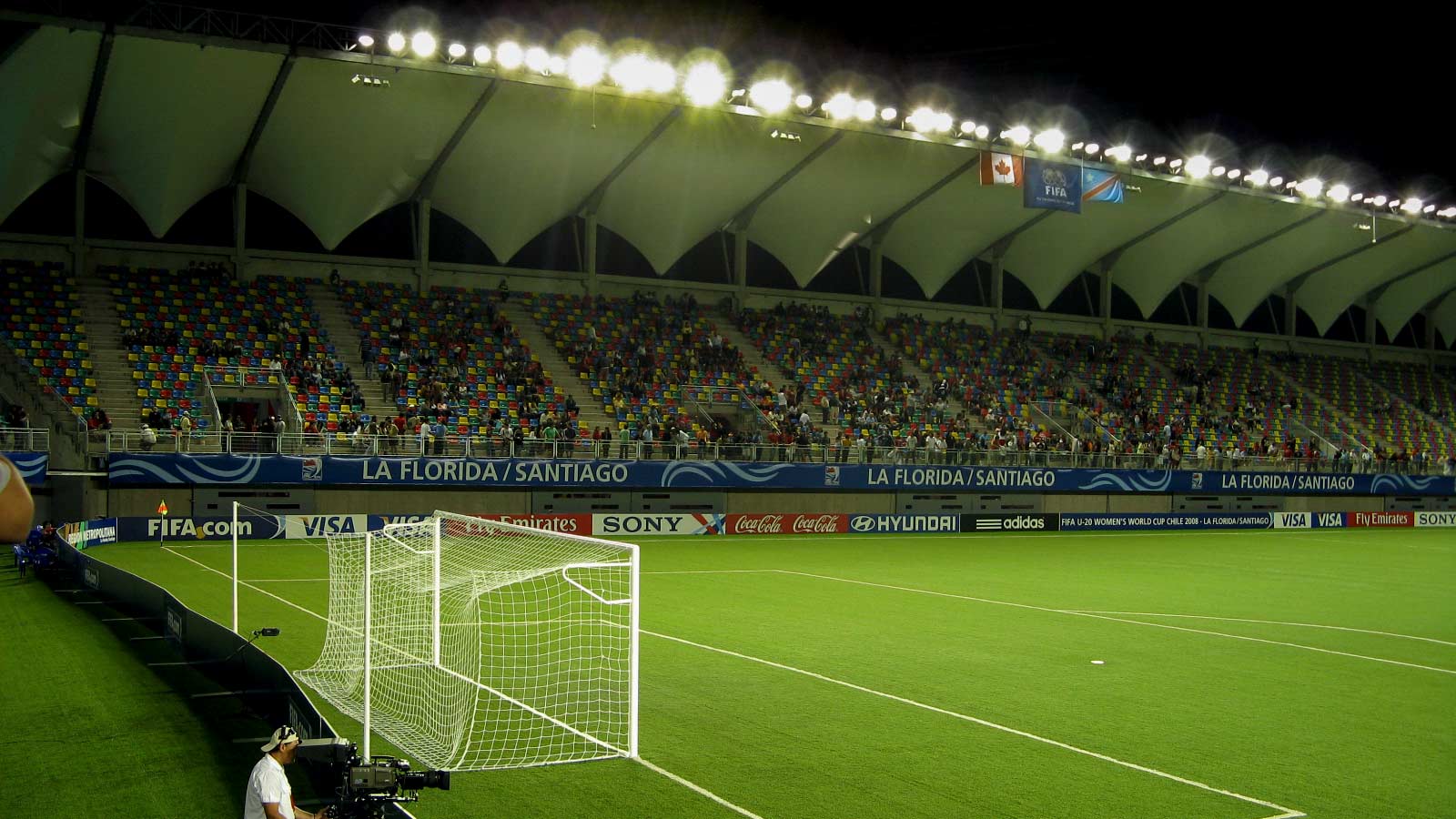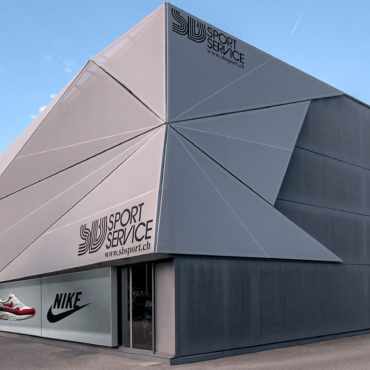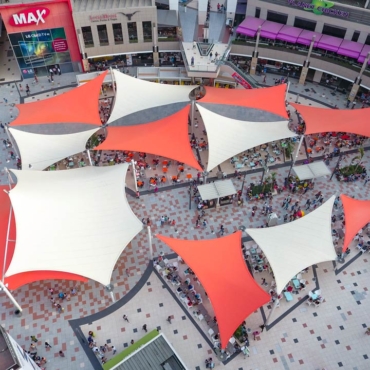
Located in the Commune of the same name, the Florida Stadium designed by the Judson & Olivos studio proposed a tensile structure as coverage, it had to meet the following requirements:
Sun and rain protection for a total of 14 rows of seats
Allow the proper location of luminaries and according to regulations.
Maintain the structural typology of the preliminary project
Be fully prepared for the Women's World Cup to be held in November.
DESIGN
Modulation:
9 types of modules were defined according to the concrete structural framework and with a total of 52 modules, they are grouped as independent blocks as follows: 12 to the North, 12 to the South, 13 to the East and 13 to the West; in each block there are between 2 and 3 types of modules.
Structural Configuration and Components:
The main components of each module are the supporting rigid structure, and the flexible structure made up of the membrane and its tensioning cables.
In turn, the rigid structure is configured by the beam column pair as the main element and by the bracing beams, one of them being the walkway beam where the luminaires are also located.
The height and inclination of the beam was conditioned by the location of the luminaires since between these and the center of the court a straight line must be generated that forms an angle between 25 and 45 degrees with the plane of the field.
The calculation of the structure was carried out by Ing. Eduardo Rodríguez with a wind load of 83 Kg. /m2
The membrane:
The design of the membrane starts from the definition of the surface or what is called Form-finding, for which the traditional physical modeling system or computational systems can be used, in this case the second was used.
The computer system also allowed us to determine the stresses on the surface and edge of the membrane, as well as to develop the pattern during the manufacturing stage.
The double-curved membrane has three rigid edges and one flexible one, the latter with a fixed point, which was positioned at a height that would allow the correct double-curved surface to be defined and the proper drainage of both cleaning and rainwater.
Clamping plates:
They are of two types, perimeter membrane union with the structure and punctual membrane union with the cables and these in turn to the structure. The design of these contemplates the ease of installation in the membrane and in the structure. The thicknesses of the materials used are in accordance with the efforts developed in the membrane.
CONSTRUCTION SYSTEM AND MATERIALS
Materials:
In membrane, Ferrari Precontraint 902 was used with a weight of 950 gr. /m2, with breaking strength (warp/weft) of 420/400 daN/5cm
And to tear (warp/weft) of 55/50 daN.
Hot-dip galvanized steel was used for the metallic elements, the same ones that were subjected to load tests according to the work they perform. The tests were developed in the laboratories of the National Engineering University of Lima (Universidad Nacional de Ingeniería - UNI)
In cables, steel cobra-type cables of 7/8 and 3/8 diameter were used, with pressed and threaded terminals in some cases and with strobes in others.
The accessories such as clamps, etc., were of the forged type
Construction system:
The constructive system of tensile structures is typified as a prefabricated system, which allows all its components to work and produce in parallel. It is especially important to have an intelligent coding so that errors are not allowed when being transported and located in its end position.
There are basically three simultaneous processes: membrane manufacturing, metal fastener manufacturing, and provision of cables with their respective accessories.
The manufacture of the membrane includes the following:
Pattern development, Cutting, Creation of membrane subblankets, Creation of membrane blankets, Placement of reinforcements, perimeter and central covers, etc., Controls, Cleaning, Packaging.
The development of the pattern is of special importance, worked with the corresponding software, pieces of approximately 1.37mt wide on average were defined, conditioned by the width of the 2.7 MT rolls of fabric.
Sun and rain protection for a total of 14 rows of seats
Allow the proper location of luminaries and according to regulations.
Maintain the structural typology of the preliminary project
Be fully prepared for the Women's World Cup to be held in November.
DESIGN
Modulation:
9 types of modules were defined according to the concrete structural framework and with a total of 52 modules, they are grouped as independent blocks as follows: 12 to the North, 12 to the South, 13 to the East and 13 to the West; in each block there are between 2 and 3 types of modules.
Structural Configuration and Components:
The main components of each module are the supporting rigid structure, and the flexible structure made up of the membrane and its tensioning cables.
In turn, the rigid structure is configured by the beam column pair as the main element and by the bracing beams, one of them being the walkway beam where the luminaires are also located.
The height and inclination of the beam was conditioned by the location of the luminaires since between these and the center of the court a straight line must be generated that forms an angle between 25 and 45 degrees with the plane of the field.
The calculation of the structure was carried out by Ing. Eduardo Rodríguez with a wind load of 83 Kg. /m2
The membrane:
The design of the membrane starts from the definition of the surface or what is called Form-finding, for which the traditional physical modeling system or computational systems can be used, in this case the second was used.
The computer system also allowed us to determine the stresses on the surface and edge of the membrane, as well as to develop the pattern during the manufacturing stage.
The double-curved membrane has three rigid edges and one flexible one, the latter with a fixed point, which was positioned at a height that would allow the correct double-curved surface to be defined and the proper drainage of both cleaning and rainwater.
Clamping plates:
They are of two types, perimeter membrane union with the structure and punctual membrane union with the cables and these in turn to the structure. The design of these contemplates the ease of installation in the membrane and in the structure. The thicknesses of the materials used are in accordance with the efforts developed in the membrane.
CONSTRUCTION SYSTEM AND MATERIALS
Materials:
In membrane, Ferrari Precontraint 902 was used with a weight of 950 gr. /m2, with breaking strength (warp/weft) of 420/400 daN/5cm
And to tear (warp/weft) of 55/50 daN.
Hot-dip galvanized steel was used for the metallic elements, the same ones that were subjected to load tests according to the work they perform. The tests were developed in the laboratories of the National Engineering University of Lima (Universidad Nacional de Ingeniería - UNI)
In cables, steel cobra-type cables of 7/8 and 3/8 diameter were used, with pressed and threaded terminals in some cases and with strobes in others.
The accessories such as clamps, etc., were of the forged type
Construction system:
The constructive system of tensile structures is typified as a prefabricated system, which allows all its components to work and produce in parallel. It is especially important to have an intelligent coding so that errors are not allowed when being transported and located in its end position.
There are basically three simultaneous processes: membrane manufacturing, metal fastener manufacturing, and provision of cables with their respective accessories.
The manufacture of the membrane includes the following:
Pattern development, Cutting, Creation of membrane subblankets, Creation of membrane blankets, Placement of reinforcements, perimeter and central covers, etc., Controls, Cleaning, Packaging.
The development of the pattern is of special importance, worked with the corresponding software, pieces of approximately 1.37mt wide on average were defined, conditioned by the width of the 2.7 MT rolls of fabric.
- Categories
- PVC MaterialSport FacilitiesTensile Cover
- Tags
- ChileStadium
- Client
- Judson & Olivos studio
- Release Date
- 2012



